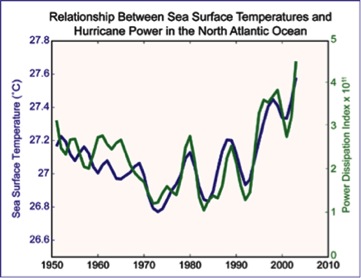SSTFlooding: Difference between revisions
From coraldigest
| Line 1: | Line 1: | ||
= Do High SSTs Increase the Risk of Flooding (and Sediment Overload)? = | = Do High SSTs Increase the Risk of Flooding (and Sediment Overload)? = | ||
*Increased flooding of nutrients and sediments | *Increased flooding of nutrients and sediments | ||
**Sediment and nutrient loads may occur as chronic long term loads and short term pulses such as river flood plumes, related to storm events. When SSTs rise it can shift the weather patterns and tracks of storms. This can lead some places to experience unusual dry spells and droughts. Increased sea surface temperatures have also been linked to more violent storms when they do occur. The dry soil quickly reaches its capacity and the water runs off into the coral reefs taking with it excess nutrients and sediments. | **Sediment and nutrient loads may occur as chronic long term loads and short term pulses such as river flood plumes, related to storm events. When SSTs rise it can shift the weather patterns and tracks of storms. This can lead some places to experience unusual dry spells and droughts. Increased sea surface temperatures have also been linked to more violent storms when they do occur. The dry soil quickly reaches its capacity and the water runs off into the coral reefs taking with it excess nutrients and sediments. <ref name=Wolanski, Eric. Oceanographic Processes of Coral Reefs: Physical and Biological Links in the Great Barrier Reef. Boca Raton: CRC, 2001. Print.</ref> | ||
**Corals thrive in a nutrient poor environment. Excess nutrients from storm water runoff gives algae an advantage and can lead to phase shifts on the coral reefs. | **Corals thrive in a nutrient poor environment. Excess nutrients from storm water runoff gives algae an advantage and can lead to phase shifts on the coral reefs. | ||
[[File:SST_and_hurricanes.jpg]] | [[File:SST_and_hurricanes.jpg]] | ||
Revision as of 23:18, 15 April 2014
Do High SSTs Increase the Risk of Flooding (and Sediment Overload)?
- Increased flooding of nutrients and sediments
- Sediment and nutrient loads may occur as chronic long term loads and short term pulses such as river flood plumes, related to storm events. When SSTs rise it can shift the weather patterns and tracks of storms. This can lead some places to experience unusual dry spells and droughts. Increased sea surface temperatures have also been linked to more violent storms when they do occur. The dry soil quickly reaches its capacity and the water runs off into the coral reefs taking with it excess nutrients and sediments. <ref name=Wolanski, Eric. Oceanographic Processes of Coral Reefs: Physical and Biological Links in the Great Barrier Reef. Boca Raton: CRC, 2001. Print.</ref>
- Corals thrive in a nutrient poor environment. Excess nutrients from storm water runoff gives algae an advantage and can lead to phase shifts on the coral reefs.
